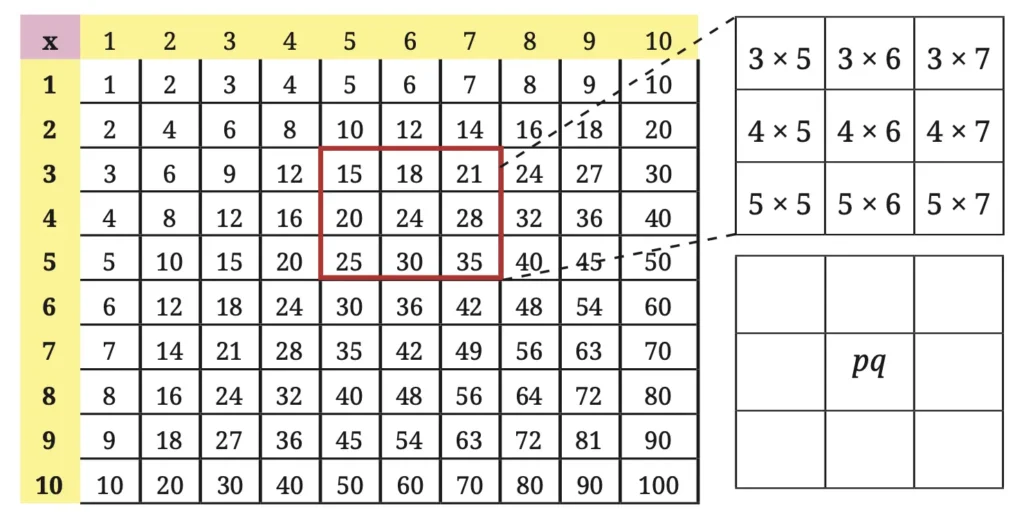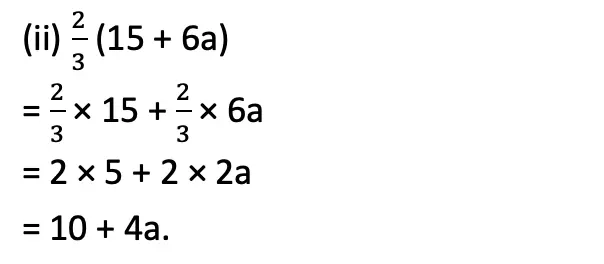Class 8 Maths Ganita Prakash Chapter 6 We Distribute, Yet Things Multiply NCERT Solutions
Textbook Page 142
1. Observe the multiplication grid below. Each number inside the grid is formed by multiplying two numbers. If the middle number of a 3 × 3 frame is given by the expression pq, as shown in the figure, write the expressions for the other numbers in the grid.

Solution:

2. Expand the following products.
(i) (3 + u) (v – 3)
(ii) 2/3 (15 + 6a)
(iii) (10a + b) (10c + d)
(iv) (3 – x) (x – 6)
(v) (–5a + b) (c + d)
(vi) (5 + z) (y + 9)
Solution:
(i) (3 + u) (v – 3)
= (3 + u)v – (3 + u)3
= 3 + uv – (9 + 3u)
= 3 + uv – 9 + 3u
= uv + 3u + 3 – 9
= uv + 3u – 6.

(iii) (10a + b) (10c + d)
= (10a + b)10c + (10 a + b)d
= 100ac + 10bc + 10ad + bd.
(iv) (3 – x) (x – 6)
= (3 – x)x – (3 – x)6
= 3x – x2 – (18 – 6x)
= 3x – x2 – 18 + 6x
= – x2 + 6x + 3x – 18
= – x2 + 9x – 18.
(v) (–5a + b) (c + d)
= (–5a + b)c + (–5a + b)d
= – 5ac + bc – 5ad + bd
= – 5ac – 5ad + bc + bd.
(vi) (5 + z) (y + 9)
= (5 + z)y + (5 + z)9
= 5y + zy + 45 + 9z
= 5y + 9z + zy + 45.
3. Find 3 examples where the product of two numbers remains unchanged when one of them is increased by 2 and the other is decreased by 4.
Solution:
If the two numbers are x and y, then:
x × y = (x + 2) × (y − 4)
xy = (x + 2)y – (x + 2)4
xy = xy + 2y – (4x + 8)
xy = xy + 2y – 4x – 8
xy – xy = 2y – 4x – 8
0 = 2y – 4x – 8
4x + 8 = 2y
2(2x + 4) = 2y
y = 2x + 4.
Examples:
(i) x = 1, y = 6 → Product = 1 × 6 = 6
Check: (1 + 2) × (6 − 4) = 3 × 2 = 6.
(ii) x = 2, y = 8→ Product = 16
Check: (2 + 2) × (8 − 4) = 4 × 4 =16.
(iii) x = 5, y =14 → Product = 5 × 14 = 70
Check: (5 + 2) × (14 − 4) = 7 × 10 = 70.
Therefore, (1, 6), (2, 8), and (5, 14) are three valid examples.
4. Expand (i) (a + ab – 3b2) (4 + b), and (ii) (4y + 7) (y + 11z – 3).
Solution:
(i) (a + ab – 3b2) (4 + b)
= (a + ab – 3b2)4 + (a + ab – 3b2)b
= 4a + 4ab – 12b2 + ab + ab2 – 3b3
= – 3b3 – 12b2 + ab2 + 4ab + ab + 4a
= – 3b3 – 12b2 + ab2 + 5ab + 4a.
(ii) (4y + 7) (y + 11z – 3)
= (4y + 7)y + (4y + 7)11z – (4y + 7)3
= 4y2 + 7y + 44yz + 77z – (12y + 21)
= 4y2 + 7y + 44yz + 77z – 12y – 21
= 4y2 + 7y – 12y + 44yz + 77z – 21
= 4y2 – 5y + 44yz + 77z – 21.
5. Expand (i) (a – b) (a + b), (ii) (a – b) (a2 + ab + b2), and (iii) (a – b)(a3 + a2b + ab2 + b3), Do you see a pattern? What would be the next identity in the pattern that you see? Can you check it by expanding?
Solution:
(i) (a − b)(a + b)
= (a − b)a + (a − b)b
= a2 – ab + ab – b2
= a2 – b2.
(ii) (a – b) (a2 + ab + b2)
= (a – b)a2 + (a – b)ab + (a – b)b2
= a3 – a2b + a2b – ab2 + ab2 – b3
= a3 – b3.
(iii) (a – b)(a3 + a2b + ab2 + b3)
= (a – b)a3 + (a – b)a2b + (a – b)ab2 + (a – b)b3
= a4 – a3b + a3b – a2b2 + a2b2 – ab3 + ab3 – b4
= a4 – b4.
The next identity would be: (a − b)(a4 + a3b + a2b2 + ab3 + b4) = a5 − b5.
